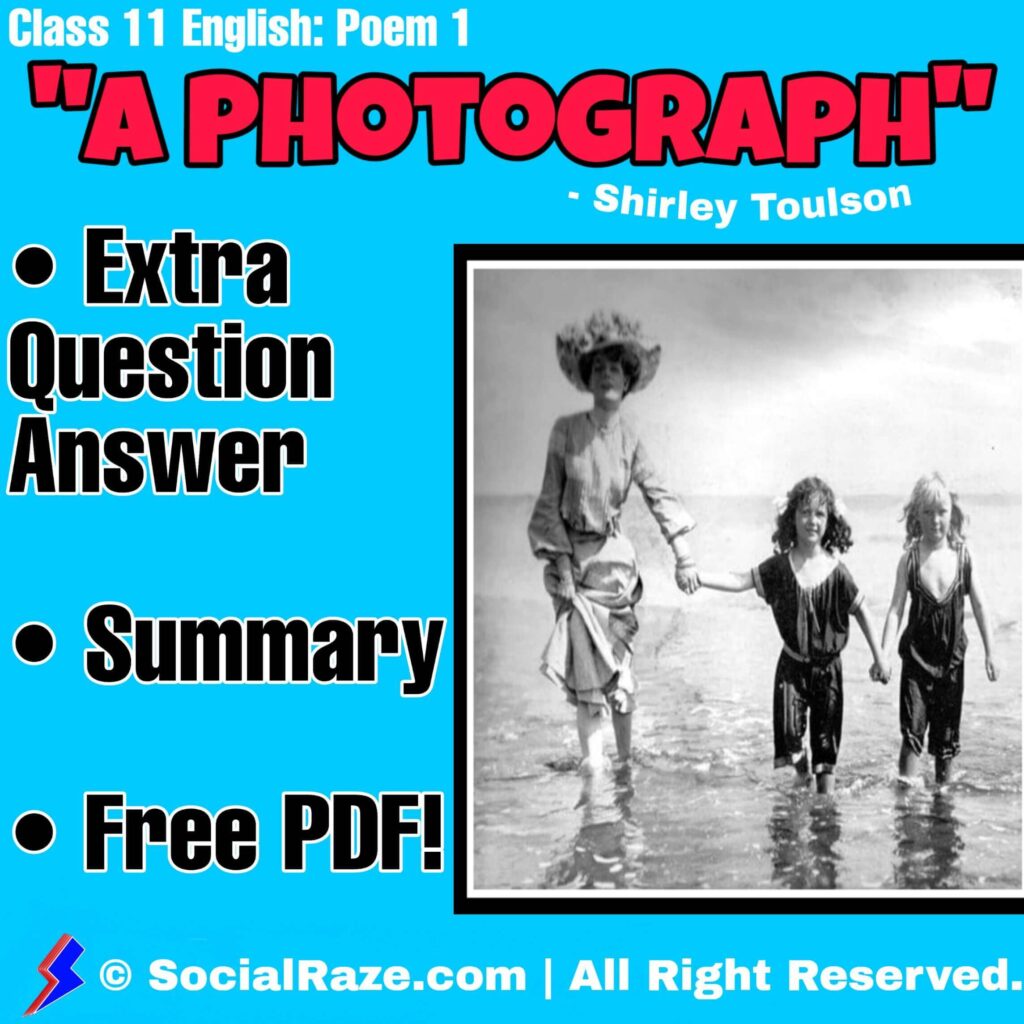This Educational Post on Class 11 English Chapter 1 “The Portrait of a Lady” by Khushwant Singh is divided into 3 parts: PDF, Summary and Extra Question Answers.
CBSE Class 11 English Hornbill: The Portrait of a Lady by Khushwant Singh PDF
Here are the Preview or Download links of NCERT Class 11 English Hornbill Book and Chapter 1 “The Portrait of a Lady” by Khushwant Singh. These are the Links to PDFs published by Official NCERT Website (ncert.nic.in).
| The Portrait of a Lady NCERT PDF | PDF View or Download Link |
| Full NCERT Hornbill Book | PDF Download Link |
The Portrait of a Lady Summary
The Portrait of a Lady is the 1st Prose from CBSE Class 11 English Hornbill Book. This is an real story of the author’s grandmother. In this story, the author describes the beautiful bond he had with her grandmother over the years and the events that led to the weakening of the common link of friendship between them.
Overall, its an emotional story with a sad ending. The story puts light on the need of companionship and friendship felt by our elders. It also shows how love and emotion is experienced not only by us human beings but also the animals and birds too.
The Portrait of a Lady Extra Questions & Answers
These are The Portrait of a Lady Extra Questions and Answers. We hope these Important Extra Question answers from “The Portrait of a Lady” will help you in your CBSE Class 11 English Subjective Tests and Exams. Let’s get started!
Why was it difficult for the author to believe that his grandmother was once young and pretty?
The author Khushwant Singh says it was hard for him to believe that his grandmother was once young and pretty because he has seen her the same old and wrinkled for the last twenty years he had known her. This shows that the author has become so used to the old wrinkled appearance of the grandmother that he finds it difficult to believe that she was once young and pretty.
How did the grandfather appear in his portrait?
The author’s grandfather’s portrait hung above the mantelpiece in the drawing room. His grandfather wore a big turban and loose-fitting clothes. His long, white beard covered the best part of his chest and he looked atleast a hundred years old. He didn’t look the sort of person who would have a wife or children. He looked as if he could only have lots of children.
How does the author portray his grandmother?
The author portrays his grandmother as an old and wrinkled woman. He describes her physical appearance as short, fat and slightly bent. He also tells that she is terribly old and could never have been pretty; but she was always beautiful. She had curly white hair, puckered face and her lips constantly moved in inaudible prayer. However, her beauty is compared to the winter landscape in the mountains , an expanse of pure white serenity breathing peace and contentment.
Why does he say, “the thought was almost revolting”?
The expression “the thought was almost revolting” means that it is hard for the author to believe that once her grandmother was young and pretty as the author had always seen her as a old and wrinkled woman for the past twenty years he had known her.
The grandmother had a divine beauty. How does the author bring this out?
The narrator had always seen his grandmother dressed in spotless white saree. She had curly white hair that used to spread over the pale and wrinkled face. The narrator described her to look like an expanse of pure white serenity. He also compared the mountains full of snow cover to look equally peaceful as his grandmother’s face.
What stories of the grandmother did the author treat as ‘fables’of the prophets? Why?
The author’s grandmother often told him the games she used to play when she was a child. That seemed quite absurd and undignified on her part to the author. So, he treated it like the ‘fables’ of the prophets.
How did the grandmother take care of the writer during his childhood?
The writer’s grandmother used to wake him up and get him ready for the school. She would fetch the school materials such as the wooden slate, ink pot, and a red pen, tie them all in a bundle and hand it over to him. She used to prepare breakfast for him and then take him to the school. Both of them shared a very special bond with each other.
Why did the grandmother accompany the narrator to his school? What did she do there?
The narrator’s grandmother always went to the school with him because the school was attached to a temple. While the children sat in rows on either side of the verandah singing the alphabet or the prayer in a chorus, the grandmother sat inside reading the scriptures. This also shows that the grandmother was very religious.
Describe the feeding of village dogs by the grandmother.
The narrator’s grandmother was a very kind hearted and loving person. While going to school with the narrator, she used to carry several stale chapattis with her for the village dogs. While returning back, the village dogs would meet them at their home growling and fighting with each other for the chapattis they threw at them.
What was the turning point in their friendship?
When the narrator’s parents were comfortably settled in the city, they were sent for them. This shift from village to city was a turning point in the friendship of the narrator with her grandmother. Although they both share the same room, his grandmother no longer came with him to school as the narrator used to go to an English School in a motor bus.
Why did the lesson at the school distress the grandmother?
The lesson at the school distressed the grandmother as it had no teaching about God and the scriptures. It taught about the western science and learning and had no connection to spirituality or religion. The author’s grandmother could not understand the the western language and hence did not believe in it.
How was the common link of friendship between the grandmother and the grandson snapped?
When the author went to university, he was given a room of his own. Both the grandmother and the grandson got separated. The long lived common link of friendship between them got snapped. But the grandmother accepted the seclusion with resignation.
How did she accept her seclusion?
The grandmother accepted her seclusion with resignation. She rarely her spinning wheel to talk to anyone. From the sunrise to the sunset, she sat by her wheel, spinning and reciting prayers. The afternoon was her only time of relaxation as she fed the sparrows in the verandah by breaking the bread into little bits.
What were the happiest moments of the day for the grandmother?
The afternoon was her only time of relaxation for the grandmother. While sitting on the verandah, she used to break the bread into little pieces and fed them to the sparrows. Hundreds of little birds collected round her and made the chirupping sound. Some perched on her legs, on the shoulders and some even on her head. She smiled and never shooed them away. These were the happiest moments of the day for the grandmother.
How did the grandmother celebrate the home coming of his grandson?
The grandmother did not pray that evening. Instead, she collected the women of her neighborhood, got an old drum and started to sing. For several hours, she thumped the sagging skin of the dilapidated drum and sang of the home-coming of warriors. This is how she celebrated her grandson’s home coming.
How did the grandmother die?
The next morning after the narrator came back home, the grandmother was taken ill. She had a mild fever and the doctor told that it would go. But his grandmother told them that her end was near. She laid peacefully in the bed praying and telling her beads. Even before they could suspect, her lips stopped moving and the rosary fell from her lifeless fingers. The grandmother was no more.
How did the Sparrow mourn the death of the grandmother?
All over the verandah and in her room right up to where she laid dead and stiff wrapped in the red shroud, thousand of sparrows sat scattered on the floor. They did not chirrup and took no notice of the bread given to them by the author’s mother. When the grandmother’s corpse was carried away off, the sparrows flew away quietly. This shows the bond between humans and animals, Although they can’t communicate with us, they do have emotions which is clearly evident in this incident.
We hope you got these Important Extra questions of CBSE Class 11 English Hornbill (NCERT) Prose 1 “The Portrait of a Lady” by Shirley Toulson, helpful for your Subjective Exams and Tests. Share it with your friends of CBSE Class 11. Thank you very much!
ALSO CHECKOUT:-
- CBSE Education
- “We are Not Afraid to Die” Extra Question Answers.
- “A Photograph” Extra Question Answers.
Topics Covered (Not For Reading):-
- Class 11 English The Portrait of a Lady by Khushwant Singh PDF Download link
- The Portrait of a Lady Summary.
- The Portrait of a Lady Extra Question Answers.
- NCERT Solutions of The Portrait of a Lady (Coming Soon)
- MCQ Questions of The Portrait of a Lady (Coming Soon)
- The portrait of a lady question bank (…)
- the portrait of a lady class 11 extract based questions with answers
- Extra Question Answer from The Portrait of a Lady.
- The portrait of a lady class 11 english hornbill chapter/prose 1.
- the portrait of a lady class 11 pdf question answer
- Important Question Answer from The Portrait of a Lady.
- the portrait of a lady questions and answers chse and cbse


